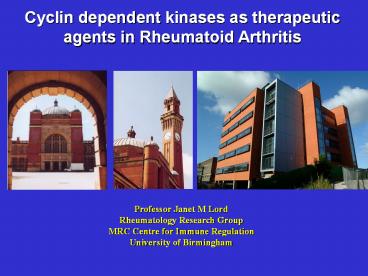Cyclin dependent kinases as therapeutic agents in Rheumatoid Arthritis - PowerPoint PPT Presentation
1 / 44
Title:
Cyclin dependent kinases as therapeutic agents in Rheumatoid Arthritis
Description:
Rheumatology Research Group MRC ... days Sample inflamed site + blood 0-3 days LGR1407 reduces the infiltration of ... model system How do the LGR compounds work? – PowerPoint PPT presentation
Number of Views:137
Avg rating:3.0/5.0
Title: Cyclin dependent kinases as therapeutic agents in Rheumatoid Arthritis
1
Cyclin dependent kinases as therapeutic agents in
Rheumatoid Arthritis
Professor Janet M Lord Rheumatology Research
Group MRC Centre for Immune Regulation University
of Birmingham
2
Lecture content
- What is Rheumatoid Arthritis?
- Neutrophils and their role in RA
- Identifying novel drugs to regulate neutrophil
function and survival - CDKs as regulators of neutrophil function and
apoptosis
3
Inflammatory Response and Rheumatoid arthritis
T
B
B
B
B
B
B
B
T
T
T
4
Meet the Neutrophil
5
Phagocytosis. Degranulation, and activation of
NADPH oxidase
Destruction of microbe
Microbe
Rolling, adhesion and diapedesis.
Phagocytosis by Tissue macrophages
6
Neutrophils and Rheumatoid Arthritis
- high numbers can be found in Synovial Fluid (SF)
- secretion of pro- inflammatory cytokines
- loss of viscosity of SF and cartilage
destruction caused by ROI and granule enzymes
result in joint damage
7
The Big Question in RA is.
Resolution
Rheumatoid Arthritis
8
Chronic inflammation in Rheumatoid Arthritis
X
TNF-a
SDF-1a
IFN-b/a
9
Neutrophil apoptosis in synovial fluid from
patients with arthritis
10
Prevention versus Treatment
11
Understanding the switch to persistence in RA
12
The early arthritis clinic
13
Ultrasound guided joint aspiration
14
Very early RA has a distinct cytokine profile
15
Synovial fluid leukocyte apoptosis is inhibited
in very early RA
16
Very early RA
Established
Normal
IL-2, IL-4, IL-13, IL-15 GM-CSF, bFGF, EGF
- Cytokine profile that is distinct transient
- This response may generate the microenvironment
required for persistent disease - IL13 bFGF promote synoviocyte proliferation and
survival - IL4 promotes DC maturation for T cell priming and
B cell differentiation and secondary lymphoid
tissue formation - Several factors promote neutrophil survival and
priming
17
Synovial cytokines prevent Neutrophil and T cell
apoptosis
T cells
18
What Next?
19
Therapy in very early RA
Does this phase represent a window in which
treatment can modify the subsequent course of
disease? What are the appropriate therapeutic
targets?
20
Therapy in very early RA
- Treat patients at very high risk of the
subsequent development of RA - Small scale pilot studies to test the therapeutic
value of specific agents - Anti-TNF etanercept B cells
rituximab - T cells CTLA4 Ig Fibroblasts and
neutrophils ?
21
Neutrophils and inflammation
- Neutrophils are the most abundant leukocytes but
are short lived (24h) - First line of defense against bacterial and
fungal infection - Removal of apoptotic neutrophils is important for
inflammation resolution - Dysregulation of neutrophil apoptosis has been
implicated in many inflammatory diseases - Neutrophils help maintain inflammation, cause
tissue damage and promote survival of autoimmune
B cells
22
First generation screen for compounds inducing
neutrophil apoptosis
23
Lead LGR compounds and Neutrophil apoptosis
EC50 1 ?M for all 3 compounds
24
LGR1406 and 1407 can inhibit GM-CSF induced
survival
25
Can LGR 1406/1407 block inflammatory effects of
neutrophils?
26
LGR1406 and 1407 inhibit GM-CSF primed neutrophil
superoxide generation
IC50 2 ?M IC50 10 ?M
27
LGR1406 and 1407 inhibit GM-CSF primed neutrophil
IL-8 release
IC50 0.1 µM
28
Next Steps
- Do the compounds work in vivo?
- Mode of action is it CDK and if so which one?
29
Testing in vivo efficacy Air pouch model
Air is injected under the skin on the back of the
mouse and 6 days later either saline or 1
carrageenan are injected into the pouch.
Inflammatory cells are recruited into the air
pouch and can be collected over a period of a
week. Systemic inflammation is minimal in this
model which represents a good model of localised
inflammation.
Sterile air
6 days
Saline or 1 Carrageenan
0-3 days
Sample inflamed site blood
30
LGR1407 reduces the infiltration of neutrophils
31
LGR1407 reduces inflammatory cytokines
in a mouse air pouch model system
32
How do the LGR compounds work?
33
LGR compounds CDK inhibitors
- Roscovitine LGR compounds
34
CDK inhibitors have anti-inflammatory activity
35
Neutrophils express only the cell cycle
independent CDKs 5, 7 and 9
A B
H N H N H N H N
H N H N H N
CDK1 CDK2 CDK4 CDK5 CDK6
CDK7 CDK9
36
CDK9 is the likely target
Inhibitor CDK1/ Cyclin B CDK2/ Cyclin E CDK4/ Cyclin D CDK5/ P25 CDK7/ Cyclin H CDK9/ Cyclin T
LGR1406 3 0.1 15 0.45 gt100 1
LGR1407 5.5 1.5 65 2 gt100 1.9
Flavopiridol
37
CDK9 is a transcriptional regulator
Cyclin T1
CDK9
RNA Pol II
TF
P
Gene transcription
38
CDK9 activity declines as neutrophils age and
enter apoptosis
0h 9h
9h
0h
CDK9
CDK9
Irr
Irr
39
CDK9 is a transcriptional regulator LGR1407
decreases Mcl-1 levels
0 2 4 6 9
12 20 hours
Mcl-1 ?-Actin Mcl-1 ?-Actin
Control 1407
40
Model of CDK9 regulation of neutrophil apoptosis
LGR1406/7
41
Summary
- Neutrophils play a key role in the early and late
stage of RA - Neutrophils are rational therapeutic targets
- CDK9 appears to regulate neutrophil apoptosis
- CDK inhibitors reduce inflammation in vivo and
represent a novel anti-inflammatory agent
42
Ongoing work - How is Neutrophil function
inhibited?
Flavopiridol
Purvalonol B
43
Acknowledgements
- Chris Buckley
- Karim Raza
- Dagmar Scheel-Toellner
- Keqing Wang
- Hema Chahal
- Peter Hampson
- Paul Pechan
- Miroslav Strnad
- Vladimir Krystof
- Libor Havlícek
- ARC
- EU FP6 C3bio
- Wyeth International
44
Age is a risk factor for conversion to persistent
RA
Persistent RA Resolving non-RA
N 19
49 Female 11
20 Age 67 (59-74) 41
(32-54) plt0.01 CRP mg/l 25 (18-41)
23 (7-56) Anti-CCP 10
2 plt0.0001 RF 10
7 plt0.0001































